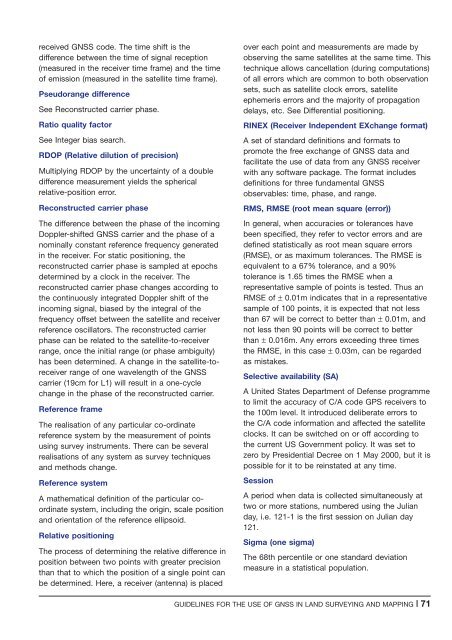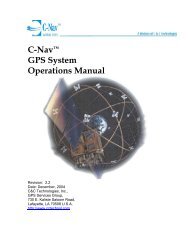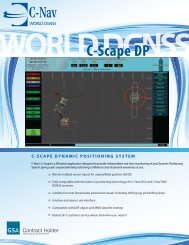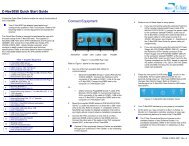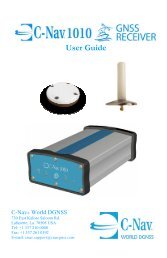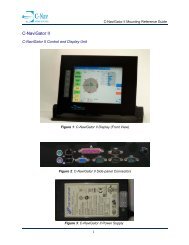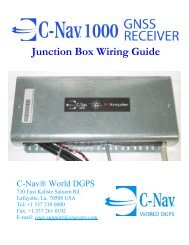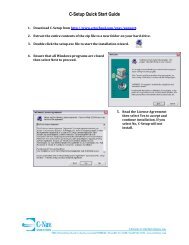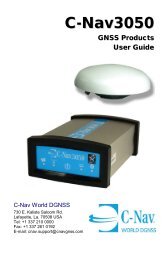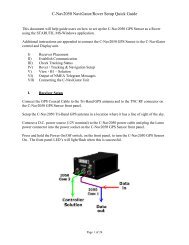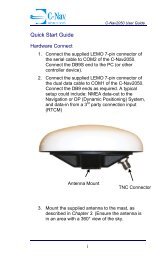Guidelines for the use of GNSS in surveying and mapping
Guidelines for the use of GNSS in surveying and mapping
Guidelines for the use of GNSS in surveying and mapping
You also want an ePaper? Increase the reach of your titles
YUMPU automatically turns print PDFs into web optimized ePapers that Google loves.
eceived <strong>GNSS</strong> code. The time shift is <strong>the</strong><br />
difference between <strong>the</strong> time <strong>of</strong> signal reception<br />
(measured <strong>in</strong> <strong>the</strong> receiver time frame) <strong>and</strong> <strong>the</strong> time<br />
<strong>of</strong> emission (measured <strong>in</strong> <strong>the</strong> satellite time frame).<br />
Pseudorange difference<br />
See Reconstructed carrier phase.<br />
Ratio quality factor<br />
See Integer bias search.<br />
RDOP (Relative dilution <strong>of</strong> precision)<br />
Multiply<strong>in</strong>g RDOP by <strong>the</strong> uncerta<strong>in</strong>ty <strong>of</strong> a double<br />
difference measurement yields <strong>the</strong> spherical<br />
relative-position error.<br />
Reconstructed carrier phase<br />
The difference between <strong>the</strong> phase <strong>of</strong> <strong>the</strong> <strong>in</strong>com<strong>in</strong>g<br />
Doppler-shifted <strong>GNSS</strong> carrier <strong>and</strong> <strong>the</strong> phase <strong>of</strong> a<br />
nom<strong>in</strong>ally constant reference frequency generated<br />
<strong>in</strong> <strong>the</strong> receiver. For static position<strong>in</strong>g, <strong>the</strong><br />
reconstructed carrier phase is sampled at epochs<br />
determ<strong>in</strong>ed by a clock <strong>in</strong> <strong>the</strong> receiver. The<br />
reconstructed carrier phase changes accord<strong>in</strong>g to<br />
<strong>the</strong> cont<strong>in</strong>uously <strong>in</strong>tegrated Doppler shift <strong>of</strong> <strong>the</strong><br />
<strong>in</strong>com<strong>in</strong>g signal, biased by <strong>the</strong> <strong>in</strong>tegral <strong>of</strong> <strong>the</strong><br />
frequency <strong>of</strong>fset between <strong>the</strong> satellite <strong>and</strong> receiver<br />
reference oscillators. The reconstructed carrier<br />
phase can be related to <strong>the</strong> satellite-to-receiver<br />
range, once <strong>the</strong> <strong>in</strong>itial range (or phase ambiguity)<br />
has been determ<strong>in</strong>ed. A change <strong>in</strong> <strong>the</strong> satellite-toreceiver<br />
range <strong>of</strong> one wavelength <strong>of</strong> <strong>the</strong> <strong>GNSS</strong><br />
carrier (19cm <strong>for</strong> L1) will result <strong>in</strong> a one-cycle<br />
change <strong>in</strong> <strong>the</strong> phase <strong>of</strong> <strong>the</strong> reconstructed carrier.<br />
Reference frame<br />
The realisation <strong>of</strong> any particular co-ord<strong>in</strong>ate<br />
reference system by <strong>the</strong> measurement <strong>of</strong> po<strong>in</strong>ts<br />
us<strong>in</strong>g survey <strong>in</strong>struments. There can be several<br />
realisations <strong>of</strong> any system as survey techniques<br />
<strong>and</strong> methods change.<br />
Reference system<br />
A ma<strong>the</strong>matical def<strong>in</strong>ition <strong>of</strong> <strong>the</strong> particular coord<strong>in</strong>ate<br />
system, <strong>in</strong>clud<strong>in</strong>g <strong>the</strong> orig<strong>in</strong>, scale position<br />
<strong>and</strong> orientation <strong>of</strong> <strong>the</strong> reference ellipsoid.<br />
Relative position<strong>in</strong>g<br />
The process <strong>of</strong> determ<strong>in</strong><strong>in</strong>g <strong>the</strong> relative difference <strong>in</strong><br />
position between two po<strong>in</strong>ts with greater precision<br />
than that to which <strong>the</strong> position <strong>of</strong> a s<strong>in</strong>gle po<strong>in</strong>t can<br />
be determ<strong>in</strong>ed. Here, a receiver (antenna) is placed<br />
over each po<strong>in</strong>t <strong>and</strong> measurements are made by<br />
observ<strong>in</strong>g <strong>the</strong> same satellites at <strong>the</strong> same time. This<br />
technique allows cancellation (dur<strong>in</strong>g computations)<br />
<strong>of</strong> all errors which are common to both observation<br />
sets, such as satellite clock errors, satellite<br />
ephemeris errors <strong>and</strong> <strong>the</strong> majority <strong>of</strong> propagation<br />
delays, etc. See Differential position<strong>in</strong>g.<br />
RINEX (Receiver Independent EXchange <strong>for</strong>mat)<br />
A set <strong>of</strong> st<strong>and</strong>ard def<strong>in</strong>itions <strong>and</strong> <strong>for</strong>mats to<br />
promote <strong>the</strong> free exchange <strong>of</strong> <strong>GNSS</strong> data <strong>and</strong><br />
facilitate <strong>the</strong> <strong>use</strong> <strong>of</strong> data from any <strong>GNSS</strong> receiver<br />
with any s<strong>of</strong>tware package. The <strong>for</strong>mat <strong>in</strong>cludes<br />
def<strong>in</strong>itions <strong>for</strong> three fundamental <strong>GNSS</strong><br />
observables: time, phase, <strong>and</strong> range.<br />
RMS, RMSE (root mean square (error))<br />
In general, when accuracies or tolerances have<br />
been specified, <strong>the</strong>y refer to vector errors <strong>and</strong> are<br />
def<strong>in</strong>ed statistically as root mean square errors<br />
(RMSE), or as maximum tolerances. The RMSE is<br />
equivalent to a 67% tolerance, <strong>and</strong> a 90%<br />
tolerance is 1.65 times <strong>the</strong> RMSE when a<br />
representative sample <strong>of</strong> po<strong>in</strong>ts is tested. Thus an<br />
RMSE <strong>of</strong> ± 0.01m <strong>in</strong>dicates that <strong>in</strong> a representative<br />
sample <strong>of</strong> 100 po<strong>in</strong>ts, it is expected that not less<br />
than 67 will be correct to better than ± 0.01m, <strong>and</strong><br />
not less <strong>the</strong>n 90 po<strong>in</strong>ts will be correct to better<br />
than ± 0.016m. Any errors exceed<strong>in</strong>g three times<br />
<strong>the</strong> RMSE, <strong>in</strong> this case ± 0.03m, can be regarded<br />
as mistakes.<br />
Selective availability (SA)<br />
A United States Department <strong>of</strong> Defense programme<br />
to limit <strong>the</strong> accuracy <strong>of</strong> C/A code GPS receivers to<br />
<strong>the</strong> 100m level. It <strong>in</strong>troduced deliberate errors to<br />
<strong>the</strong> C/A code <strong>in</strong><strong>for</strong>mation <strong>and</strong> affected <strong>the</strong> satellite<br />
clocks. It can be switched on or <strong>of</strong>f accord<strong>in</strong>g to<br />
<strong>the</strong> current US Government policy. It was set to<br />
zero by Presidential Decree on 1 May 2000, but it is<br />
possible <strong>for</strong> it to be re<strong>in</strong>stated at any time.<br />
Session<br />
A period when data is collected simultaneously at<br />
two or more stations, numbered us<strong>in</strong>g <strong>the</strong> Julian<br />
day, i.e. 121-1 is <strong>the</strong> first session on Julian day<br />
121.<br />
Sigma (one sigma)<br />
The 68th percentile or one st<strong>and</strong>ard deviation<br />
measure <strong>in</strong> a statistical population.<br />
GUIDELINES FOR THE USE OF <strong>GNSS</strong> IN LAND SURVEYING AND MAPPING |71


